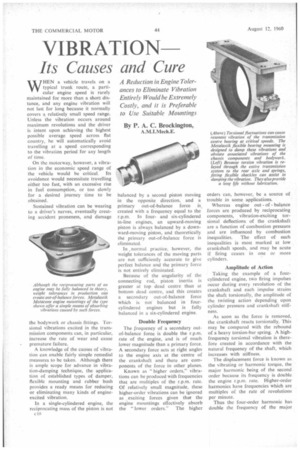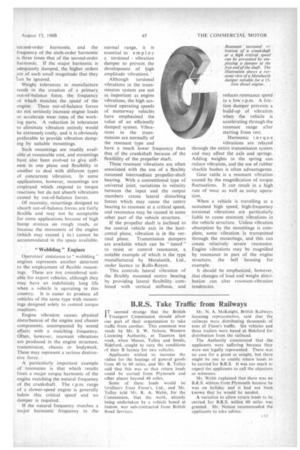VIBRATION
Page 50

Page 51

If you've noticed an error in this article please click here to report it so we can fix it.
Its Causes and Cure
A Reduction in Engine Tolerances to Eliminate Vibration Entirely Would be Extremely Costly, and it is Preferable to Use Suitabk Mountings By P. A. C. Brockington,
A.M.I.Mech.E. WHEN a vehicle travels on a typical trunk route, a particular engine speed is rarely maintained for more than a short distance, and any engine vibration will not last for long because it normally covers a relatively small speed range. Unless the vibration occurs around maximum revolutions and the driver is intent upon achieving the highest possible average speed across flat country, he will automatically avoid travelling at a speed corresponding to the vibration period for any length of time.
On the motorway, however, a vibration in the economic speed range of the vehicle would be critical. Its avoidance would necessitate travelling either too fast, with an excessive rise in fuel consumption, or too slowly for a desired journey time to be obtained.
Sustained vibration can be wearing to a driver's nerves, eventually creating accident proneness, and damage the bodywork or chassis fittings. Torsional vibrations excited in the transmission components can, in particular, increase the rate of wear and cause premature failure.
A knowledge of the causes of vibration can enable fairly simple remedial measures to be taken. Although there is ample scope for advance in vibration-damping technique, the application of established types of damper, flexible mounting and rubber bush provides a ready means for reducing or eliminating many kinds of engineexcited vibration.
In a single-cylindered engine, the reciprocating mass of the piston is not 'IC balanced by a second piston moving in the opposite direction, and a primary out-of-balance force is created with a frequency equal to the r.p.m. In fourand six-cylindered in-line engines, an upward-moving piston is always balanced by a downward-moving piston, and theoretically the primary out-of-balance force is eliminated.
In normal practice, however, the weight tolerances of the moving parts are not sufficiently accurate to give perfect balance and the primary force is not entirely eliminated.
Because of the angularity of the connecting rod, piston inertia is greater at top dead centre than at bottom dead centre, and this creates a secondary out-of-balance force which is not balanced in fourcylindered engines but is fully balanced in a six-cylindered engine.
Double Frequency
The frequency of a secondary outof-balance force is double the r.p.m. rate of the engine, and is of much lower magnitude than a primary force. A secondary force acts at right angles to the engine axis at the centre of the crankshaft and there are components of the force in other planes.
Known as "higher orders," vibrations can be produced with frequencies that are multiples of the r.p.m. rate. Of relatively small magnitude, these higher-order vibrations can be ignored as , exciting forces given that the engine mountings effectively absorb the " lower orders." The higher orders can, however, be a source of trouble in some applications.
Whereas engine out of balance forces are produced by reciprocating components, vibration-exciting torsional deflections of the crankshaft are a function of combustion pressure and are influenced by combustion inequalities. The effect of such inequalities is most marked at low crankshaft speeds, and may be acute if firing ceases in one or more cylinders.
Amplitude of Action
Taking the example of a fourcylindered engine, two firing impulses occur during every revolution of the crankshaft and each impulse strains the shaft torsionally, the amplitude of the twisting action depending upon cylinder pressure and crankshaft stiffness.
As soon as the force is removed, the crankshaft reacts torsionally. This may be compared with the rebound of a heavy torsion-bar spring. A highfrequency torsional vibration is therefore created in accordance with the natural frequency of the shaft, which increases with stiffness.
The displacement force is known as the vibrating or harmonic torque, the major harmonic being of the second order because its frequency is double the engine r.p.m. rate. Higher-order harmonics have frequencies which are multiples of the rate of revolutions per minute.
Thus the four-order harmonic has double the frequency of the major second-order harmonic, and the frequency of the sixth-order harmonic is three times that of the second-order harmonic, If the major harmonic is adequately damped, the higher orders are of such small magnitude that they an be ignored.
Weight tolerances in manufacture result in the creation of a primary out-of-balance force, the frequency of which matches the speed of the engine. These out-of-balance forces do not seriously increase engine loads or. accelerate wear rates of the working parts. A reduction in tolerances to eliminate vibration entirely would be extremely costly, and it is obviously preferable to provide vibration damping by suitable mountings.
Such mountings are readily available at reasonable cost, and mountings have also been evolved to give stiffness in one plane and flexibility in another to deal with different types of concurrent vibration. In some applications, however, mountings are employed which respond to torque reactions but do not absorb vibrations caused by out-of-balance forces.
Of necessity, mountings designed to absorb out-of-balance forces are fairly flexible and may not be acceptable for some applications because of high bump stresses on rough roads, or because the movement of the engine (which may exceed in.) cannot be accommodated in the space available.
" Wobbling " Engines
Operators resistance to" wobbling" engines represents another deterrent to the employment of flexible mountings. These are not considered suitable for export vehicles, although they may have an indefinitely long life when a vehicle is operating in this country. It is easier to produce all vehicles of the same type with mountings designed solely to control torque reactions.
Engine vibration causes physical disturbances of the engine and chassis components, accompanied by sound effects with a matching frequency. Often, however, resonant vibrations are produced in the engine structure, transmission, chassis or bodywork. These may represent a serious destructive force.
A particularly important example of resonance is that which results from a major torque harmonic of the engine matching the natural frequency of the crankshaft. The r.p.m. range of a slower-speed engine is generally below this critical speed and no damper is required.
If the natural frequency matches a major harmonic frequency in the normal range, it is essential to employ a torsional vibration damper to prevent the development of high amplitude vibrations.
Although torsional vibrations in the transmission system are not as important as engine vibrations, the high sustained operating speeds of motorway vehicles have emphasized the value of an efficiently damped system. Vibrations in the transmission are normally of the resonant type and have a much lower frequency than that of the crankshaft because of the flexibility of the propeller shaft.
These resonant vibrations are often associated with the use of a flexibly mounted intermediate propeller-shaft bearing. With a conventional type of universal joint, variations in velocity between the input and Ore output members create lateral disturbing forces which may cause the centre bearing to resonate at a critical speed, and resonance may be caused in some other part of the vehicle structure.
If the propeller shaft is inclined to the central vehicle axis in the horizontal plane, vibration is in the vertical plane. Transmission dampers are available which can be " tuned " to resist or control resonance, a notable example of which is the type manufactured by Metalastik, Ltd., under licence to Rolls-Royce.
This controls lateral vibration of the flexibly mounted centre bearing by providing lateral flexibility corn-. bined with vertical stiffness, and reduces resonance speed to a low r.p.m. A friction damper prevents a build-up of vibration when the vehicle is accelerating through the resonant range after starting from rest.
Harmonic torque vibrations are relayed through the entire transmission system and may affect the axle and springs. Adding weights to the spring can reduce vibration, and the use of rubber shackle bushes is often advantageous.
Gear rattle is a resonant vibration caused by the magnification of torque fluctuations. It can result in a high rate of wear as well as noisy operation.
When a vehicle is travelling at a sustained high speed, high-frequency torsional vibrations are particularly liable to cause resonant vibrations in the vehicle structure. Unless vibration absorption by the mountings is complete, some vibration is transmitted through the mountings, and this can create relatively severe resonance. Engine vibrations may be magnified by resonance in part of the engine structure, the bell housing for example.
It should be emphasized, however, that changes of load and weight distribution can alter resonant-vibration tendencies.
















































































































